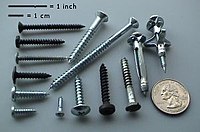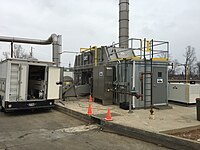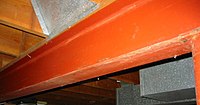
Shear lag effect in tension flange of RC walls with flanged sections
Sign Up to like & getrecommendations! Published in 2017 at "Engineering Structures"
DOI: 10.1016/j.engstruct.2017.04.017
Abstract: Abstract A new method for considering the shear lag effect in the flange of reinforced concrete (RC) walls with flanged sections is proposed. The method is developed based on the truss analogy for the cracked… read more here.
Keywords: walls flanged; method; lag effect; flange ... See more keywords

The shear-lag effect of composite box girder bridges with corrugated steel webs and trusses
Sign Up to like & getrecommendations! Published in 2019 at "Engineering Structures"
DOI: 10.1016/j.engstruct.2018.12.048
Abstract: Abstract The composite box girder bridge with corrugated steel webs and trusses is a recently proposed enhanced composite box girder bridge structure. The shear-lag effect of this kind of structure is studied in detail in… read more here.
Keywords: shear lag; composite box; steel; lag effect ... See more keywords

A nonlinear shear-lag model applied to chemical anchors subjected to a temperature distribution
Sign Up to like & getrecommendations! Published in 2018 at "International Journal of Adhesion and Adhesives"
DOI: 10.1016/j.ijadhadh.2018.05.002
Abstract: Abstract Adhesive joints are increasingly used in bridges and buildings construction thanks to their high mechanical properties and their ease of implementation. However, the load transfer mechanism within adhesive joints is complex and has been… read more here.
Keywords: temperature; temperature distribution; chemical anchors; model ... See more keywords

Multiscale Shear-Lag Analysis of Stiffness Enhancement in Polymer-Graphene Nanocomposites.
Sign Up to like & getrecommendations! Published in 2017 at "ACS applied materials & interfaces"
DOI: 10.1021/acsami.7b03159
Abstract: Graphene and other two-dimensional (2D) materials are of emerging interest as functional fillers in polymer-matrix composites. In this study, we present a multiscale atomistic-to-continuum approach for modeling interfacial stress transfer in graphene-high-density polyethylene (HDPE) nanocomposites.… read more here.
Keywords: multiscale shear; graphene; stress; lag analysis ... See more keywords

Analysis of Pure Bending Vertical Deflection of Improved Composite Box Girders with Corrugated Steel Webs
Sign Up to like & getrecommendations! Published in 2021 at "Advances in Civil Engineering"
DOI: 10.1155/2021/6617846
Abstract: Steel bottom plates are applied as replacements for the concrete bottom plates in order to reduce the dead weight of the composite box girders with corrugated steel webs and steel bottom plates (CSWSB). Due to… read more here.
Keywords: box girders; vertical deflection; deflection; box ... See more keywords

An analysis model accounting for time-dependent shear lag effects in assembled composite bridge decks
Sign Up to like & getrecommendations! Published in 2022 at "Advances in Structural Engineering"
DOI: 10.1177/13694332221080601
Abstract: The concrete deck of steel-concrete composite bridges made via prefabricated construction consists of precast slabs and construction joints between the slabs. When the age difference between the longitudinal joint concrete and precast slab concrete (new-old… read more here.
Keywords: time; time dependent; concrete; model ... See more keywords

Shear lag effect in steel-concrete composite beam in hogging moment
Sign Up to like & getrecommendations! Published in 2019 at "Steel and Composite Structures"
DOI: 10.12989/scs.2019.31.1.027
Abstract: Shear lag effect can be an important phenomenon to consider in design of the steel-concrete composite beams. Researchers have found that the effect can be strongly related with the moment distribution, the stiffness and the… read more here.
Keywords: steel; shear lag; lag effect; concrete composite ... See more keywords

Analysis of shear lag effect in the negative moment region of steel-concrete composite beams under fatigue load
Sign Up to like & getrecommendations! Published in 2021 at "Steel and Composite Structures"
DOI: 10.12989/scs.2021.39.4.435
Abstract: Shear lag effect was a significant mechanical behavior of steel-concrete composite beams, and the effective flange width was needed to consider this effect. However, the effective flange width is mostly determined by static load test.… read more here.
Keywords: shear lag; lag effect; negative moment; load ... See more keywords

Parametric Analysis of the Shear Lag Effect in Tube Structural Systems of Tall Buildings
Sign Up to like & getrecommendations! Published in 2020 at "Applied Sciences"
DOI: 10.3390/app11010278
Abstract: Horizontal loads such as earthquake and wind are considered dominant loads for the design of tall buildings. One of the most efficient structural systems in this regard is the tube structural system. Even though such… read more here.
Keywords: lag effect; structural systems; tall buildings; tube structural ... See more keywords